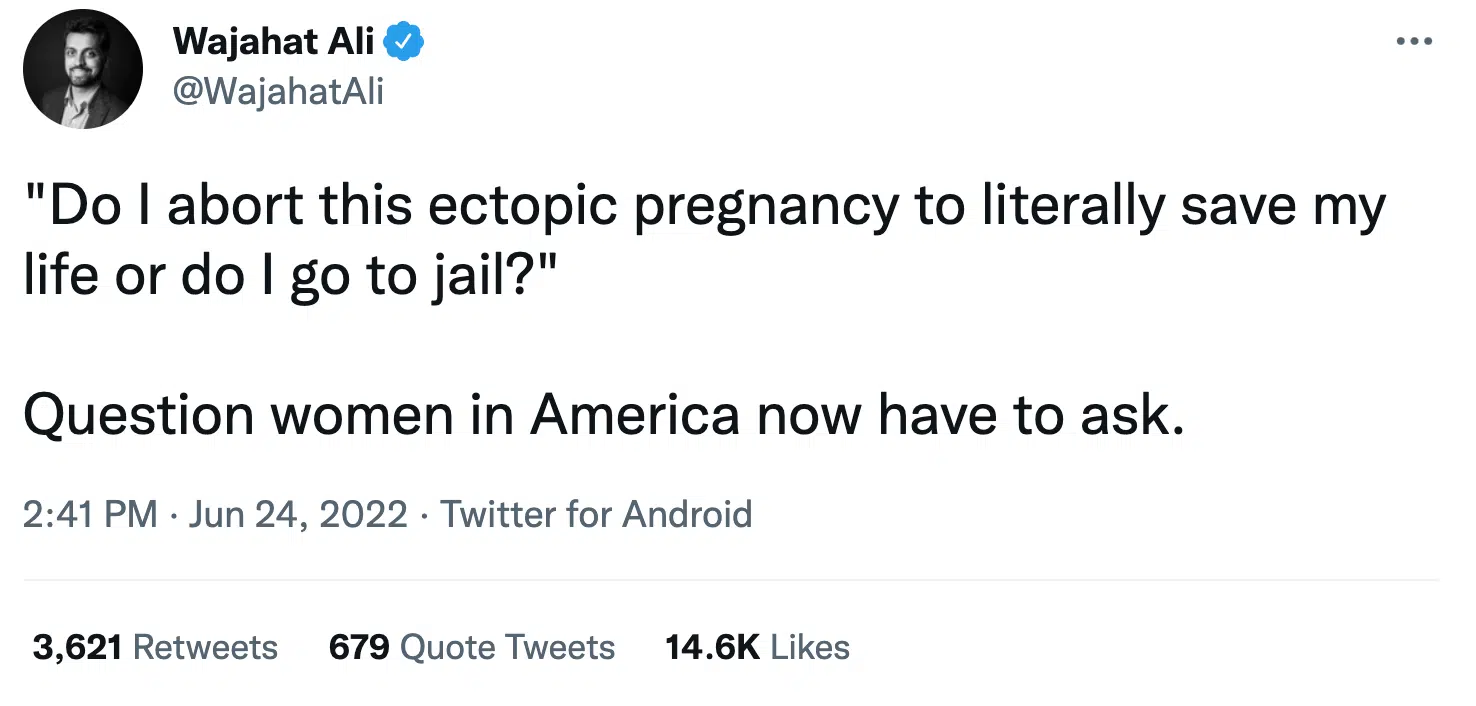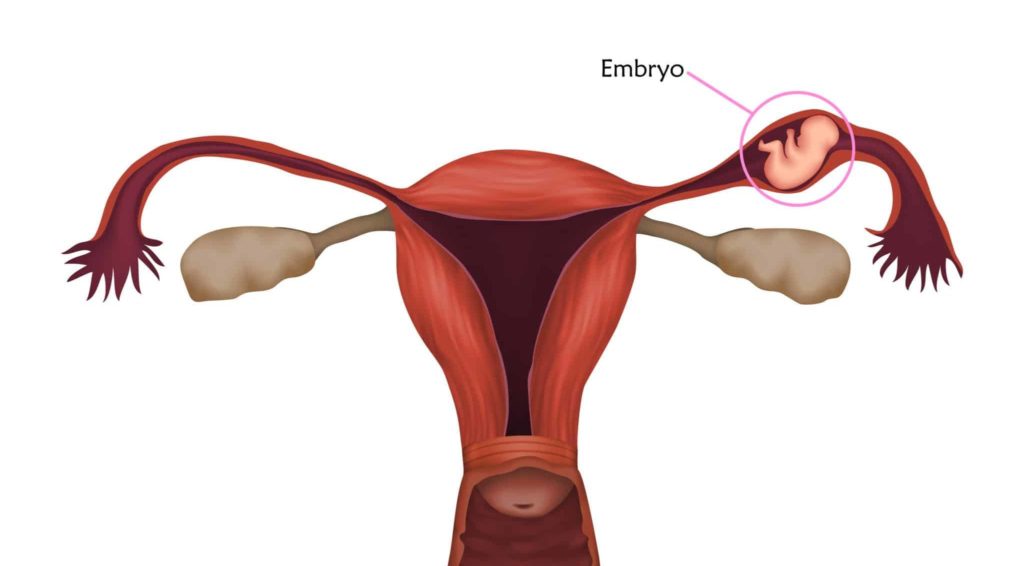Ectopic Pregnancy: Dispelling Misinformation

Susan Ciancio has a BA in psychology and a BA…
Since the reversal of Roe v. Wade and Casey v. Planned Parenthood, we have seen anger. We have seen violence. And we have seen the dispersal of all kinds of misinformation—most of it aimed at increasing rage and stirring up indignation.
One of the pieces of misinformation spreading rapidly pertains to ectopic (literally, “out of place”) pregnancies.
I’m sure you’ve seen it on your social media feeds or on the news. I know I have. Otherwise intelligent people are falling into the trap of believing erroneous tweets like this one from Daily Beast writer Wajahat Ali:

From Twitter
This is irresponsibility at its best. Many people seem to enjoy posting false information to see how much anger and vitriol they can stir up.
That’s why it’s so important to understand the truth and to have factual information ready when we see posts like this. Changing abortion laws will most certainly not affect women who have ectopic pregnancies.
But first, let us understand what an ectopic pregnancy actually is and how treatment for ectopic pregnancy differs from abortion.
What Is an Ectopic Pregnancy?
An ectopic pregnancy happens when the newly created embryo implants outside of the uterus. This usually occurs in one of the fallopian tubes, but it can also occur in an ovary, in the cervix, or in the abdominal cavity.

Illustration of an ectopic pregnancy
Sadly, an embryo who has implanted in a place other than the uterus cannot survive. If, for instance, she continues to grow in a fallopian tube, her growth will eventually cause the tube to burst—which is a potential life-threatening event for the mother.
Because of this—and because there is no way to save a baby who has implanted outside the uterus—steps must be taken to save the mother’s life by removing the embryo.
Sometimes the baby is miscarried. But if she has not already been miscarried, doctors must remove her from where she has implanted.
We will explain the different procedures below, but keep in mind this fact: The removal of an embryo from a place outside the uterus and who cannot survive where she has implanted is vastly different from abortion. An abortion is the intentional killing of a preborn baby.
https://www.youtube-nocookie.com/embed/LzY4-6hoW2E?controls=0
In treating an ectopic pregnancy, the mother and the doctor do not intend the death of the baby. It’s a tragic and unintended result of a necessary treatment. Doing nothing will likely end in the serious injury or death of the mother.
How Common Is Ectopic Pregnancy?
According to the March for Dimes, one out of 50 pregnancies results in an ectopic pregnancy. Other estimates put it a little lower—about one out of 100. Regardless, this is a relatively rare event that is exacerbated by several risk factors.
These risk factors include whether or not the woman smokes. Factors also include prior surgery, scars on the fallopian tubes, age, and whether or not a woman has had an STD. This is important to know because STDs often lead to pelvic inflammatory disease, which damages the fallopian tubes and increases the scarring. This scarring could cause the embryo to get stuck en route to the uterus.
When an ectopic pregnancy does happen, the parents are usually devastated. The hopes and dreams they had for their little one are shattered, and they must now deal with the death of their child.
This is often a very traumatic experience to endure. That’s why there are many organizations that will help the parents heal emotionally, especially as the procedure to remove the embryo may be very difficult—emotionally and physically.
Methods for Removal of Ectopic Pregnancy
According to the National Catholic Bioethics Center, there are three ways in which doctors can remove an embryo who has implanted outside the uterus.
1) Salpingectomy: In this procedure, doctors remove one or both fallopian tubes or a part of one, including the embryo.
This procedure is “considered morally permissible by Catholic ethicists under the principle of double effect.” The NCBC explains that “the death of the embryo is a foreseen and unintended effect of an act directed at removing the pathologically affected section of the fallopian tube.”
2) Salpingostomy: In this procedure, “the fallopian tube is sliced longitudinally; the damaged tissue and embryo are removed. The death of the embryo is part of the act of removing the embryo from the tube.”
Some ethicists believe that salpingostomy is moral because “the act by its object removes the trophoblast [a layer of tissue that supplies nourishment to the embryo]; removal of the embryo is a foreseen and unintended side effect.”
However, many Catholic ethicists see this as morally impermissible.
3) Methotrexate: Methotrexate is an anti-cancer drug.

When used by a woman with an ectopic pregnancy, methotrexate
interferes with DNA synthesis in rapidly dividing tissue, such as that of the trophoblast and the embryo. The intent in its use is to release the embryo from its dangerous position. The object is to slow the rapid development of the trophoblast so that it detaches, but when released into the uterus, the embryo is no longer able to attach to it. Since the trophoblast will become the placenta, vital to the embryo, some see this as a direct attack on a vital organ of the embryo.
Moral ethicists have long debated the moral licitness of these procedures. So let’s learn about the principle of double effect to determine why there is so much debate.
The Principle of Double Effect
According to a First Things article, the principle of double effect teaches that a person
may perform a good action even if it is foreseen that a bad effect will arise only if four conditions are met: 1) The act itself must be good. 2) The only thing that one can intend is the good act, not the foreseen but unintended bad effect. 3) The good effect cannot arise from the bad effect; otherwise, one would do evil to achieve good. 4) The unintended but foreseen bad effect cannot be disproportionate to the good being performed.
Related: What Is the Principle of “Double Effect”?
The Ethics of Salpingectomy
The NCBC explains how the principle of double effect applies to the use of salpingectomy. It goes through all four criteria, outlining why this procedure is morally licit. Salpingectomy is good because:
- The “removal of the affected fallopian tube [is] not a direct attack on the embryo.”
- “The intent is to prevent tubal rupture, while the foreseen but unintended effect is the death of the embryo.”
- “The removal of the diseased fallopian tube, not the concurrent death of the embryo (evil effect) is the cause of the good effect (prevention of tubal rupture).”
- “There is a proportionate reason: No matter what is done, there is no chance of survival for the embryo, but without treatment, the mother’s life is at great risk; currently, there is no alternative procedure that can save the embryo, even if nothing is done.”
The Ethics of Salpingostomy
The NCBC then explains how the principle of double effect applies to the case of a salpingostomy:
The object of the procedure appears morally problematic, despite the good moral intent. While the procedure is intended to remove the diseased fallopian tube tissue, in which the embryo’s trophoblast (to become the placenta) has embedded, salpingostomy looks like a direct attack on the embryo. The procedure is not as mutilating for the woman as is a salpingectomy; hence, it is often recommended by physicians. Unlike salpingectomy, salpingostomy preserves the fallopian tube and thus helps protect future fertility. Among those who favor salpingostomy, this is perceived as a proportionate benefit.
The Ethics of Methotrexate
There is less support among ethicists for the use of methotrexate, as it “appears to be a direct attack on the embryo.”
However, the document concludes by stating that the Magisterium of the Catholic Church is “silent on these three specific procedures.” So, because the Magisterium has not made a declaration about the use of these three treatments, the decision which to use is left up to the parents of the ectopic embryo. They must seek to understand the ethical and medical ramifications, and use their conscience to make a decision.
Will Women Be Prosecuted for Ectopic Pregnancy Treatments?
Many women (and men) are screaming that women will be prosecuted for having one of these procedures done to remove an ectopic pregnancy.
Let’s be extremely clear: This is not true.
Having an ectopic pregnancy removed is not an abortion.
As we stated previously, an abortion is the direct and intentional taking of the life of a preborn baby. This is not the case in the removal of an embryo who has implanted outside the uterus.
A human embryo approximately 6 weeks from conception. Photo by Lunar Caustic, CC BY 2.0.
Treating an ectopic pregnancy is nothing like killing a baby intentionally, and women will never be prosecuted for this. In fact, women will not even be prosecuted for having an abortion.
In an interview with The Pillar, O. Carter Snead, a law professor and director of the de Nicola Center for Ethics and Culture at the University of Notre Dame, explained that “no modern abortion laws provide for the prosecution of women for seeking abortion.” The last time—and only time—this happened was in 1922 when an Indiana woman “was convicted for unlawfully self-managing an abortion under the state feticide statute.” However, an appellate court vacated her conviction as a “misconstruction of the law at issue, which [did] not apply to abortions.”
Snead went on to explain, “The recent proposal to prosecute women made by a Louisiana legislator was immediately and roundly criticized by his pro-life lawmaker colleagues, the pro-life governor, and national pro-life leaders. The proposal was withdrawn.”
Regarding the erroneous claims by some news outlets that have suggested that women will be prosecuted for having a miscarriage, Snead responded: “This is a highly misleading and, I think, sophistical claim. These cases [of prosecuting women] have involved women who have used illegal drugs, thus negligently causing the deaths of their unborn children that they had not intended to abort.” According to Snead, these were cases of child neglect that was applied in utero.
Finally, Snead noted that the claim that women will not receive care for ectopic pregnancies or miscarriages is also false. Even the states with the most restrictive laws—Oklahoma, Texas, and Alabama—make “explicit exceptions for ectopic pregnancy and miscarriage management.”
These are the facts we must understand. And these are the truths we must speak loudly, especially when we hear or read false or misleading reports.
Related: What Percentage of Abortions Are Medically Necessary?
Final Thoughts
Social media, major news outlets, and many television shows profit from their fearmongering. They want to create dissention. They want people to feel anger. And they don’t care about the facts as they go about their dishonest work.
So, when you hear half-truths and outright lies, be prepared to defend the truth.
Women will never be prosecuted for electing to have a procedure to remove an ectopic pregnancy.
What's Your Reaction?
Susan Ciancio has a BA in psychology and a BA in sociology from the University of Notre Dame, with an MA in liberal studies from Indiana University. Since 2003, she has worked as a professional editor and writer, editing both fiction and nonfiction books, magazine articles, blogs, educational lessons, professional materials, and website content. Fourteen of those years have been in the pro-life sector. Currently Susan writes weekly for HLI, edits for American Life League, and is the editor of its Celebrate Life Magazine. She also serves as executive editor for the Culture of Life Studies Program, an educational nonprofit program for k-12 students.

















